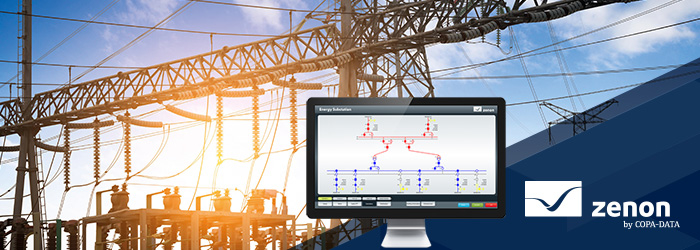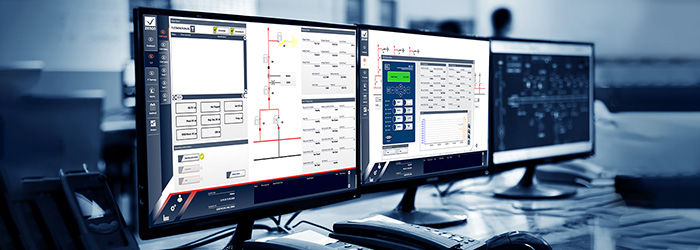Login (User Login; top right of page) with your web user or complete this form to download.
zenon can help you digitalize your power assets for better control and reliability

On this site you find:
- What is a digital substation?
- Implementing a digital substation
- Application Set Substation HMI
- Best practices
The need for consistent and reliable power is crucial for many businesses. Often, this can lead to reliance on a power distribution network that is overstrained and doesn’t have the efficiency to keep up with modern power needs. When power outages occur, businesses are left to deal with them, many times leading to increased costs. To encounter this challenge and ensure high reliability and power quality from the electrical network, utilities strive to modernize and streamline substation automation technology in so called digital substations. Through use of standardized digital interfaces and data, zenon aids power companies in managing electrical grids efficiently. Learn more about what constitutes a digital substation, and what zenon can do for your business today.
What is a digital substation?
Traditionally, substations have been used to distribute electricity to homes and businesses. Since high voltages and powerflow have to be maintained and various protection functions have to be managed in substations, there is a large reliance on analog and binary status data to maintain these exact outputs. Unfortunately, a downfall of traditional substations lies within processing and using this data, which can use a large amount of labor and power to compute. Digital substation architecture looks to minimize these inefficiencies by digitalizing the substation data. This provides multiple benefits, such as flexible software-based functions, as well as streamlining data sharing between devices. Overall, digital substations provide greater reliability and flexibility in the background of the growing dynamics in the grid.

What components make up a digital substation?
Substations have relied on a large number of copper cables to transfer signals between different sections and devices. Apart from the obvious inefficiencies, these cables require a considerable amount of space within the plant and manual labor for installation. They are used to connect current and voltage transformers and circuit breakers to relays, requiring thousands of meters of copper cables. One main advantage with a digital substation comes from swapping these out for digital communication, based on fiber-optic cables, which allow the entire system to interact flexibly via dedicated communication protocols.
The crucial role of IEDs: realizing central monitoring and control for enhanced efficiency
Intelligent Electronic Devices (IEDs) help control and protect the operation of equipment found within a substation, such as transformers and circuit breakers. The use of microprocessors within IEDs helps automate certain power grid processes, such as analyzing data and limiting asset or power-quality issues. Overall, IEDs for digital substations are in line with the IEC 61850 standard for automating substations, which means they support a unified data model, communication protocols, functions and services making them interoperable with other devices and systems. For plant developers, this leads to simpler management of plant design, configuration and commissioning though a unified set of tools and functions.
So, what makes a digital substation improved over a conventional substation?
Future substations need to be able to cope with more dynamic requirements in terms of power quality and power flow. Moreover, for utilities to manage the growing number of assets in an economic way, new practices of developing, commissioning and monitoring energy assets with unified and precise tools need to be adopted. The IEC 61850 standard for digital substations meets these requirements and helps utilities to get ready for the next generation energy grid.
Implementing a digital substation
The first step towards implementing a Digital Substation comes from a proper understanding of IEC 61850 architecture. The automation standard brought forward by IEC 61850 has led to the realization that substations need to be digitized in order to keep up with modern power needs. However, the most crucial feature present in a digital substation is the process bus. This allows connections between IEDs to be realized on the basis of flexible communication protocols, and eliminates the need for hard-wiring. Overall, the process bus allows for connections across the substation to be streamlined and more flexible.
Standardization
IEC 61850 has led to the practice of standardization among digital substations. This is necessary so that the world’s substations do not develop discrepancies, and energy distribution can be regulated and controlled on a larger scale. Substation automation software, like zenon, takes into account international protocols in its operation, making it simple for substation managers to stay in line with agreed practices.
Communication networks
One of the core features of a digital substation is the conversion of process information, such as measurements and states, into telegrams of the respective IEC 61850 communication protocol.This information can then be flexibly communicated to other devices across the substation, leading to optimal flexibility. This can be achieved using IEC 61850-compliant IEDs, as well as utilizing digital substation software. By effectively monitoring this data, one can ensure that all sections of a substation are working properly, greatly decreasing faults and errors.
Best practices
The number one best practice for implementing and operating a digital substation is adherence to the numerous international communications network standards, such as IEC 61850. These standards help lay the groundwork for efficient data sharing and interoperability. Additionally, using the right data management tool, such aszenon, helps provide efficiency in managing digital substations, including remote management. By identifying which sections of a substation must be controlled manually and which can be automated, one can optimally operate a digital substation.
Global Success Stories
The role of IEC 61850
IEC 61850 has been mentioned, but what does it consist of, and how can it help with the efficiency of digital substation communication? IEC 61850 was created to standardize the design of substations and the communication of IEDs on an international level. As an increasing number of power grids across the world plan to digitize their substations, IEC 61850’s protocol standards have become common practice to adhere to. It can also providesafety through the use of fiber optic cables and security functions according to IEC 62351.
Choose zenon for all your digital substation needs
Managing or entering the digital substation market can feel overwhelming. Luckily, zenon can simplify this process. zenon is designed for flexibility, meaning it is optimized for on-site and remote maintenance, whether you need to take a manual approach or focus on automation. For more information, contact COPA-DATA today!





















































